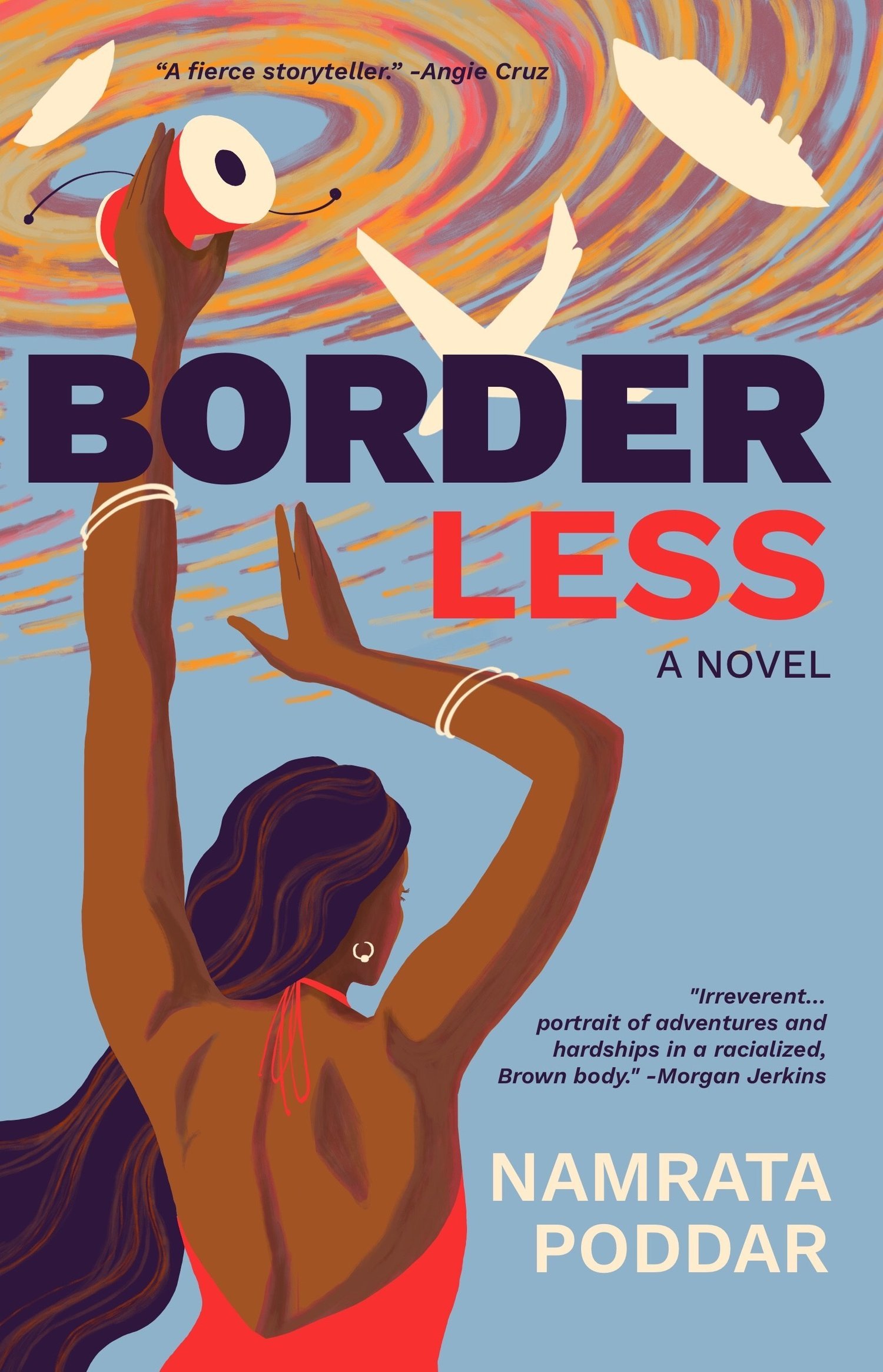Reviewed by Rachel León
Matthew Salesses’ Craft in the Real World helped many of us rethink how we judge literature (particularly by writers of a cultural background different from our own) through explaining how what we value in writing is a standard set by a Western canon largely comprised of cis straight white men. Held by this standard, Namrata Poddar’s debut novel, Border Less, could be dismissed for being fragmented and lacking a traditional narrative arc—qualities that are virtues or flaws depending on the cultural framework through which one chooses to view the work. Removing such a lens—which can be a challenge for white readers, this reviewer included—reveals Border Less as an elegant meditation on not only race, class, gender, and migration but also storytelling itself. It challenges, even confronts, the white, Western standard of what a novel is and should do.
The novel is divided into two parts. The first, “Roots,” opens at a call center in Mumbai, where the protagonist, Dia, is introduced. She is juggling work, college, and caring for an ailing parent while setting her sights set on a promotion—a necessary step toward the goal she shares with her boyfriend to search for a better life. After the chapter’s conclusion, we meet another woman in Mumbai, followed by a group of women commuting home from work on the train, which raises the question, asked explicitly by the chapter’s narrator, “Who plays the central character and who becomes footnotes in that fragmented city with a hollow center?” Its placement has the feel of a call and response: from there, we revisit Dia, who is preparing to migrate to America and leave behind her entire life. This is followed by a conversation between two hotel employees after the hotel has been renovated following a terrorist attack, in which one notes, “Everything in this country, everything everywhere sucks up to white skin.” This remark is commentary, a whispered premonition, and simple observation all rolled into one.
“Routes,” set in America, follows the same pattern as “Roots:” chapters weave between the perspective of Indian American immigrants and Dia, whose story is revisited after years have passed and her circumstances have changed. Little explanation for the changes is offered—another craft decision seemingly fueled by an aim to disrupt traditional storytelling standards. The missing answers to “how” and “why” such changes occur seems to be by the author’s design—the reader is meant to carry these questions of the in-between, just as these characters carry the burden of navigating the unknown—not to mention living in a Brown body in a racist and xenophobic country that has weaponized and othered those without white skin. One character notes, “Soon though, every cliché on India I’d heard from white folks in the West, my new brown family in the West was recycling—joke after joke on the motherland’s lack of civilization, the poverty, the population, the heat, the dirt, the slums, especially the slums.” The comment may hearken the reader back to the first half of the novel where such stereotypes are challenged by the array of perspectives and experiences of South Asians: call center agents, fashion designers, blue and white-collar workers, Bollywood artists, single mothers, and academics. Again and again, this novel offers lines to help the reader’s understanding, reminding them that its fragmented form, the narrative’s staccato rhythm, and the way the prose often plays with the English language are all intentional.
No example of such assistance is as direct as an italicized metaphor that sits in an unusual place, dangling at the end of a scene and before another: A chair is not just a chair, it’s a tree in a forest, it’s a tree removed from a forest, a resting place for the tired, a challenge for the handicapped. Always, bachcha, look at a situation from multiple perspectives. Its placement feels odd, but not random, appearing almost as if it is the novel’s thesis statement. Because, of course, that’s what Poddar has offered here: an opportunity for the reader to see the forest, if you will, with the characters removed. If the novel had only provided Dia’s perspective, it would lack its richness and texture, its innate rhythm—in other words, what makes Border Less so distinct. As is the way it brashly tackles issues of colonization and othering not only in this country, but in literature itself, head-on:
With your alabaster team, you then discuss how to better my story, how to purge it of its fobby syntax, its fragmentation and staccato rhythm, its identity politics, its upward mobility, and Jesus H., its quiet domesticity. How solemnly you mediate my voice so my story may do more—pursue more character, more action, more conflict, more suffering, shut up more to show more—and become relatable to the hu-man-ity of all.
The way this novel predicts how many readers will criticize its shape and then calls into question those (white) assumptions has a powerful effect—a disarming one—certainly reminding one of Salesses’ argument. The characters are connected by different things: some by social relationship, others by geography, still others by a quest for agency. This web and large cast characters is not only a subtle—yet explicitly stated—metaphor but also an examination of the way Brown border-crossing people must negotiate power due to race, class, gender, and religion. There’s much to admire about Border Less: the bold risks it takes with narration and structure, its carefully constructed layers, the depth of character revealed in a tight space, and its examination of what it means, and costs, to belong. But perhaps its most impressive virtue is its staunch rejection of the measurements the white Western canon uses to judge literature and its confident demand to be read on its own terms.

